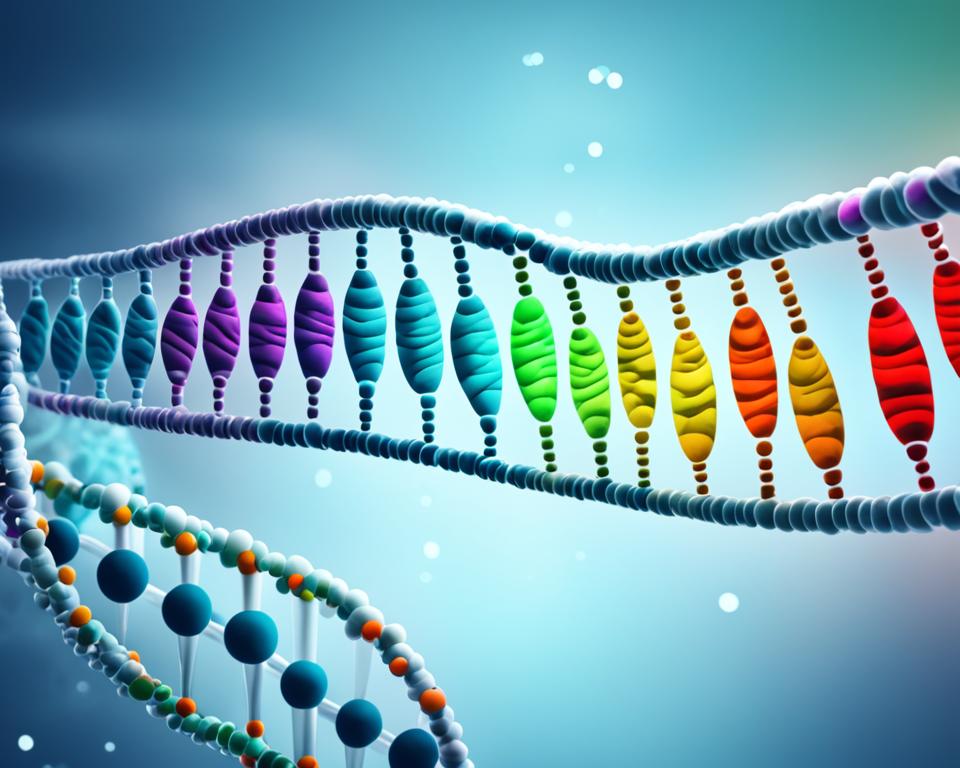Understanding how to communicate with a nonverbal autistic child is a challenge many parents, caregivers,…

Autism Risk: Assessing Your Child’s Chances
Understanding the chances of having a child with autism is a concern that touches many families around the world. Every parent grappling with such probabilities seeks clear, reliable information that might shed light on the future of their child’s health and well-being. While autism is undeniably complex, various autism risk factors, including genetic, environmental, and developmental patterns, have been recognized by researchers aiming to provide clarity for concerned caregivers.
The intricate autism inheritance pattern complicates straightforward risk assessment, but advancements in genetic research have begun to untangle these complexities. Simultaneously, growing autism prevalence rates emphasize the importance of early screening and intervention in managing the condition. These developmental efforts carry the potential to significantly improve life trajectories for those on the autism spectrum.
As we embark on this exploration, it is essential for parents and healthcare professionals alike to recognize the early signs of autism and utilize validated screening tools. This proactive approach allows for timely support and a better understanding of the resources at our disposal. Let’s delve into the underlying factors that contribute to an increased likelihood of autism and the ways to navigate this challenging landscape with knowledge and compassion.
Prenatal and Genetic Indicators of Autism
Understanding the intricate tapestry of factors contributing to autism spectrum disorder (ASD) is essential for parents and healthcare providers alike. Both genetic predispositions and prenatal environments play significant roles in the potential development of ASD, creating a multifaceted risk profile that can be daunting to unravel.
The Role of Family History and Genetics
Groundbreaking research has demonstrated that a family’s genetic makeup can be a reliable indicator when evaluating the risk of autism. A notable increase in autism probability is present in families with a history of the condition, suggesting a strong genetic predisposition to autism. Identifying around 102 genes associated with ASD, the genetic complexity becomes apparent, with certain genes elevating risk more than others. Twin studies bolster these findings, with identical twins showing a remarkably high concordance rate when it comes to autism, strongly supporting the autism inheritance pattern among siblings.
- Genetic predisposition increases the likelihood of developing autism
- Identical twins have higher concordance rates, hinting at strong genetic links
- Syndromes like fragile X and tuberous sclerosis are associated with increased rates of ASD
Environmental Factors Influencing Prenatal Development
Alongside genetics, prenatal exposure to certain environmental factors plays a pivotal role. Substances such as heavy metals, certain pesticides, and medications like valproic acid during critical developmental windows are all environmental players in the increased risk of autism. These environmental factors autism contributions highlight the need for awareness and precaution during pregnancy. Despite ongoing research, some connections, such as those with SSRI medications, remain less clear, suggesting the complexity of these risk factors.
- Environmental toxins during pregnancy linked to higher ASD risk
- Certain medications can contribute to the development of autism
- Infections and metabolic issues during pregnancy could elevate autism risk
Maternal and Paternal Age Factors
The age of parents particularly maternal age autism risk has also been scrutinized. Babies born to older parents are shown to have a higher incidence of autism. While the science is still evolving, the data suggest that age-related genetic mutations could be influencers in the condition’s onset. This information serves as a crucial piece of the puzzle, emphasizing the relevance of genetic factors alongside parental age. The trend of later parenthood, especially in developed countries, calls for more research to understand its implications on ASD.
- Parental age, especially in older parents, is linked to greater autism risk
- Research into the connection between parental age and ASD is ongoing
By considering these genetic, environmental, and age-related elements, those assessing autism risk can gain invaluable insights, although a definitive predictor of the condition remains elusive. The complexity of ASD requires a nuanced approach to understanding its origins and inheritance, underlining the importance of continuous research and consideration of all contributing factors.
Recognizing Early Signs of Autism in Infants and Toddlers
Understanding the early development of children with autism is key to recognizing the early signs of autism. Parents often observe their child’s development closely, and any deviations from typical developmental milestones can be a cause for concern. These early signs are often subtle, but they may include a lack of eye contact, a delay in speech development, or a child not responding to their name by the age of 12 months.
Expert monitoring is advised to evaluate the presence of characteristics associated with autism. A vigilant approach to observing a child’s behavior, particularly between 12 to 18 months, can lead to timely intervention if required. Leadership in this role often falls to parents and caregivers, who are in a privileged position to notice changes or delays in their child’s development.
- Failure to establish consistent eye contact
- Limited pointing or gesturing by 12 months
- Infrequent smiling or social responsiveness
- Delayed babbling and speech development
- Lack of interest in playing with other children
- Uncommonly fixated interests or repetitive behaviors
When regression in development is noticed, it indicates a greater need for evaluation. This regression may manifest as a loss of previously acquired speech, social, or motor skills. Receptive to these early signs, healthcare professionals can employ tools such as the Modified Checklist for Autism in Toddlers, Revised with Follow-Up (M-CHAT-R/F) and the Ages and Stages Questionnaires (ASQ) to help pinpoint concerns that may warrant closer scrutiny.
These screening tools are integral in narrowing the possible developmental gaps through early intervention strategies. When used properly, the M-CHAT-R/F and ASQ enable quicker identification and support for children demonstrating early signs of autism, potentially mitigating long-term impacts on learning and development.

Chances of Having a Child with Autism: Calculation and Prediction
As we delve deeper into the intricacies of autism, we find ourselves equipped with data and tools that aid in understanding the intricate tapestry of factors contributing to autism prevalence. Contemporary research suggests that the frequency of autism diagnoses is on the rise, attributed to moreso heightened autism awareness and refined diagnostic practices rather than an actual escalation of the disorder itself. With every step forward, the medical community develops increasingly sophisticated methodologies to not just examine existing rates, but to also forecast the potential for autism in future generations.
Understanding Autism Prevalence Rates
The question of how common autism truly is can be complex, but current global data provides a touchstone, estimating that roughly 1 in 100 children are designated as living with an Autism Spectrum Disorder (ASD). Such statistics serve a critical role in shaping our societal, medical, and educational responses to the condition. Despite the initial impression of growing autism rates, these numbers more accurately reflect advances in our collective consciousness and the tools at our disposal for identifying the condition early on.
Utilizing Autism Risk Assessment Tools
To parse the layers upon layers of hereditary, environmental, and developmental elements intertwined with ASD, professionals now have at their disposal cutting-edge autism risk assessment tools. Devices like the Autism Risk Calculator have been developed to amalgamate risk factors and, through precise algorithms, offer an estimated probability of a child developing autism. The intention of these tools is not to definitively forecast autism but to signal when a family might benefit from further professional evaluation or consultation.
- Assessment tools consider a range of factors including familial history and genetic predisposition.
- Environmental exposures and their potential to influence developmental outcomes are also integrated into the risk calculations.
- The tools provide an initial estimate, prompting individuals to seek tailored advice from healthcare practitioners where there’s an elevated risk.
Ultimately, these risk assessment resources serve as both a testament to our progression in understanding ASD and a beacon for those navigating the uncertain waters of potential diagnosis.
Conclusion
Understanding the landscape of autism risk factors is a multifaceted endeavor. It revolves around the critical interconnection of genetic predispositions, environmental influences, and family medical histories. While it remains true that no singular marker or combination of markers can guarantee a precise forecast of autism, the cumulative knowledge of these dimensions offers us a framework for assessing autism risk with increasing accuracy. Fostering awareness around these factors propels advancements in detection and supports epidemiological insights.
Recent strides in the realm of early identification are pronounced, with sophisticated screening tools and an invigorated emphasis on vigilance during critical developmental windows. These enhancements in diagnostic practices have invariably led to a surge in autism recognition. This uptick is not necessarily indicative of a burgeoning prevalence but rather a testament to our evolving understanding of the spectrum and a more inclusive approach to its diagnosis.
Acknowledging that autism is a lifelong journey emphasizes the importance of the support for autism that spans the entire lifespan. From the moment of early concerns to the implementation of interventions and beyond, individuals with autism can access a broad spectrum of resources designed to aid them in leading enriched and fulfilling lives. It remains crucial for families, healthcare providers, and educators to continue nurturing an environment filled with support, understanding, and opportunities for those on the autism spectrum.
FAQs
What factors increase the chances of having a child with autism?
Several factors can increase the chances, including genetic predisposition, such as a family history of autism, environmental influences during prenatal development, and the age of the parents at the time of conception. There is no single factor that guarantees a child will be autistic, but the combination of these elements can affect overall risk.
How does family history contribute to the risk of autism?
A family history of autism significantly raises the risk for a child. This can be due to specific genetic factors, with some research suggesting that over 100 genes might be involved. When autism runs in families, it may indicate an underlying genetic predisposition.
Are there environmental factors that could raise the risk of a child developing autism?
Yes, there are certain environmental factors during pregnancy that can increase the risk of a child developing autism. These include exposure to environmental toxins, certain pesticides, heavy metals, and specific medications. Furthermore, viral infections or metabolic imbalances in the mother during pregnancy have also been associated with a higher risk of autism in the child.
Does the age of the parents affect the risk of having a child with autism?
Research has shown that children born to older parents may have a higher risk of autism, although definitive conclusions on this correlation are still being investigated. As the parents’ age increases, especially at the time of conception, the risk factors associated with genetic mutations and chromosomal abnormalities may also increase, thereby potentially raising the chance of having a child on the autism spectrum.
What are the early signs of autism in infants and toddlers?
Early signs of autism in infants and toddlers can include delayed speech and language skills, lack of eye contact, limited interest in social interactions, repetitive behaviors, and sometimes, a regression in skills they had previously acquired. Parents and caregivers are often the first to notice these early indications, which can manifest before the child reaches 18 to 24 months old.
How is the prevalence rate of autism calculated?
Autism prevalence rates are calculated based on the number of individuals diagnosed with autism spectrum disorder (ASD) within a certain population. Statistics are obtained through diagnostic screenings, health records, and surveys. Global estimates suggest about 1 in 100 children has been diagnosed with ASD.
How can I use autism risk assessment tools to understand the chances of my child having autism?
Autism risk assessment tools, like the Autism Risk Calculator, use algorithms that factor in genetic, environmental, and family history to estimate the risk of autism. These tools offer statistical likelihoods and can be a starting point for further evaluation by professionals. They are not definitive predictors but can be helpful in determining if a more detailed assessment is needed.



This Post Has 0 Comments